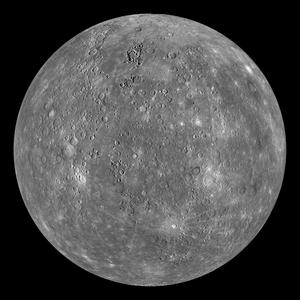Glossary term: Mercury
Description: Mercury is the closest planet to the Sun and the smallest of the eight major planets in the Solar System. It is a rocky, terrestrial planet with a radius of about 2500 kilometers (km), which is slightly larger than the Earth's Moon. It has a mass of 0.055 times the mass of the Earth. Due to its close distance, the Sun is seven times brighter seen from Mercury, and Mercury's surface is much affected by the solar wind. Its very thin exosphere is made of material produced by this interaction, plus matter blasted off the surface due to frequent falling objects. The thin atmosphere cannot keep the planet's temperature, so the surface is extremely cold (-180 degrees Celsius) during the night, and extremely hot (400 degrees Celsius) during the day, and thus very dry.
Its typical distance from the Sun is about 58 million km, about 0.39 astronomical units (Earth–Sun distances), taking a little under 88 days to complete one orbit. Mercury has no moons known to orbit it.
As Mercury orbits the Sun closer than the Earth, it always appears close to the Sun in the sky. Mercury is named after the speedy Roman messenger god, derived from its fast motion across the sky. Two space probes (Mariner 10 and MESSENGER) have visited Mercury, with the BepiColombo mission due to arrive in the mid-2020s.
Related Terms:
See this term in other languages
Term and definition status: This term and its definition have been approved by a research astronomer and a teacher
The OAE Multilingual Glossary is a project of the IAU Office of Astronomy for Education (OAE) in collaboration with the IAU Office of Astronomy Outreach (OAO). The terms and definitions were chosen, written and reviewed by a collective effort from the OAE, the OAE Centers and Nodes, the OAE National Astronomy Education Coordinators (NAECs) and other volunteers. You can find a full list of credits here. All glossary terms and their definitions are released under a Creative Commons CC BY-4.0 license and should be credited to "IAU OAE".
If you notice a factual error in this glossary definition then please get in touch.
Related Media
Mercury
Credit: NASA/Johns Hopkins University Applied Physics Laboratory/Carnegie Institution of Washington credit link
License: PD Public Domain icons
Moon-Mercury-Pleiades Conjunction
Credit: Giulio Colombo/ IAU OAE
License: CC-BY-4.0 Creative Commons Attribution 4.0 International (CC BY 4.0) icons
Venus and Mercury Trails
Credit: Marcella Giulia Pace (CC BY 4.0)
License: CC-BY-4.0 Creative Commons Attribution 4.0 International (CC BY 4.0) icons











